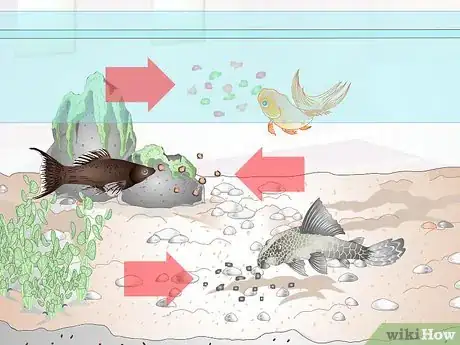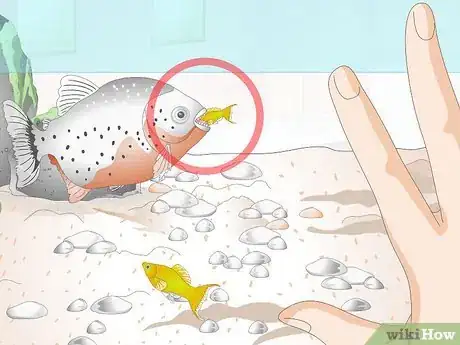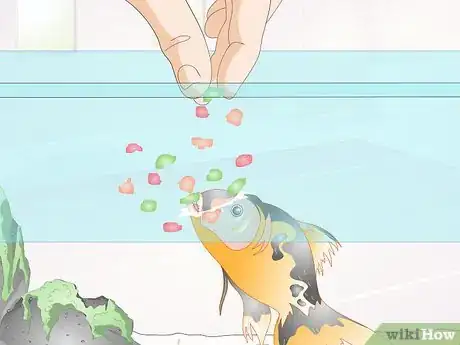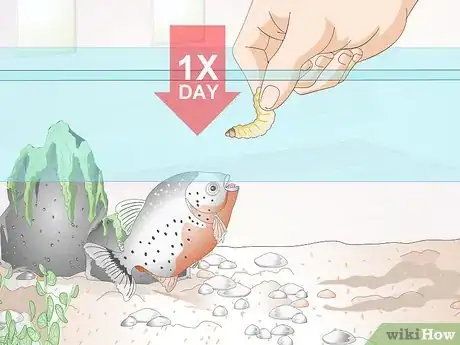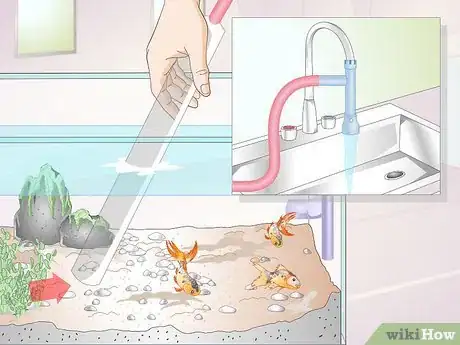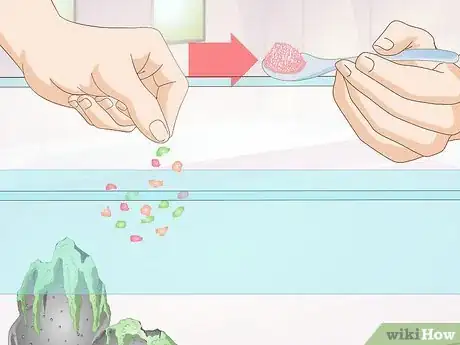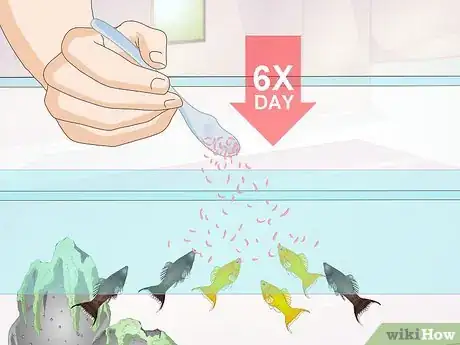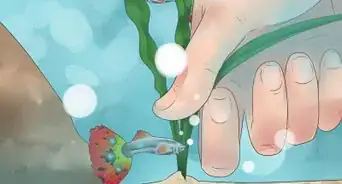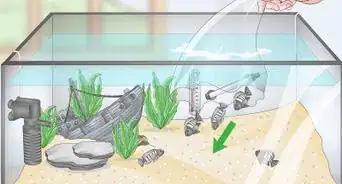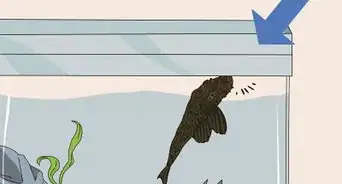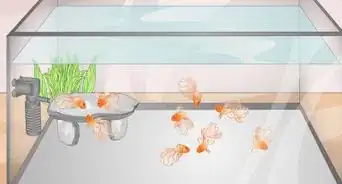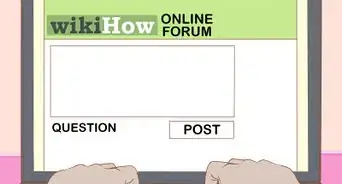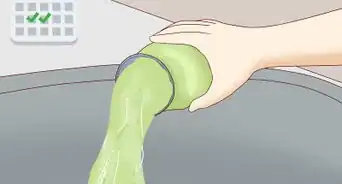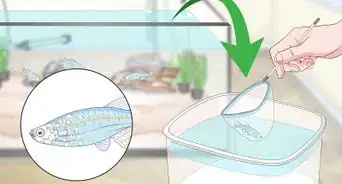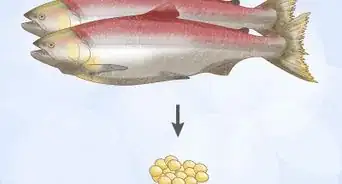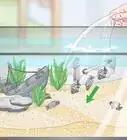This article was co-authored by Marshall Stephens. Marshall Stephens is an Aquarium Expert at Private Oceans Aquariums in West Palm Beach, Florida. Marshall has over 20 years of experience in the aquarium industry and focuses on captive-bred animals. They specialize in tropical and marine aquariums and are a contributor to the Loggerhead Marine life center in Jupiter Florida.
wikiHow marks an article as reader-approved once it receives enough positive feedback. In this case, several readers have written to tell us that this article was helpful to them, earning it our reader-approved status.
This article has been viewed 63,537 times.
Tropical fish are a fun and colorful addition to your home, and will thrive with the right care. This includes keeping their tank clean and at the right temperature, and of course, feeding them properly. Feeding is not a difficult process once you know your fish and the best kinds of food for them. As long as you avoid some simple mistakes, you’ll be able to keep your fish happy and well fed.
Steps
Learning About Your Fish’s Diet
-
1Find out how your fish eat. Different kinds of fish like their food at different levels of the tank. Their mouths are designed to approach food in a certain way, so you’ll need to know their preferred way of feeding. Look at your fish’s mouth to determine where it likes to eat its food. [1]
- Surface feeders have up-turned mouths for reaching up to the surface of the water. Hatchetfish and gouramies are common surface-feeders.[2] These fish like having their food as flakes or floating pellets.
- Mid-level feeders, like barbs and tetras, have forward-facing mouths, and will prefer food that sinks from the surface, but not necessarily reaches the floor of the tank. In addition, they may prefer tablets that can be stuck to the side of the tank, which lets them eat in full view of you and anyone you want to see your fish.
- Bottom feeders have downward-facing mouths, and like to graze on food that sits at the bottom of the tank. Plecos and Cory Catfish are popular bottom feeders.[3] If you have bottom feeders, make sure you get heavier pellets or other food that will sink to the bottom of the tank.
- Be sure to get the right size, quality, and kind of food for your particular fish, as that is extremely important for its well-being.
-
2Learn what your fish will eat. There are many different species of tropical fish, and while they can have specific diets in the wild, they will generally fit into three categories depending on the kind of food they eat. If you are unsure what kinds of fish you have, check with the pet store you bought them from, or a veterinarian.[4]
- Carnivores. These fish like a large, protein rich diet. They will mostly likely have large mouths full of sharp teeth for tearing their food apart. If you have predator fish, just be careful about the other fish in your tank, as they may try to eat other, smaller fish.
- Herbivores. These fish have smaller stomachs and flat teeth for grinding plant material. They will want plant and vegetable matter, and you’ll need to feed them in small amounts, and with more frequency.
- Omnivores. This covers most aquarium fish, and they will eat a wide variety of food. Because of this variety, they are generally easier to take care of.
Advertisement -
3Get the right type of food. While many fish have specific diets when they are out in the wild, most foods available in a pet store will provide your pets with the needed nutrients. While there are many specific brands and types of foods, they will generally all fit into several categories. Talk to the pet store about the best options for the fish you have.[5] [6]
- Dry foods. These are the most common types of foods, and can come in various forms including flakes, pellets, tablets, and sticks. If you use flakes, you’ll probably need to use quite a bit of them to make sure your fish get enough to eat. You can also get larger tablets that sink to the bottom of the tank for bottom feeders and scavengers.
- Frozen foods. These are mixtures of food that can provide different nutrients, though you’ll need to vary them even more than with dry foods to make up for deficiencies. You can store frozen foods in your freezer, and just drop them into the tank. The tank’s warm water will thaw out the food for your fish. Avoid foods that have been thawed and refrozen.
- Live foods. Some fish, especially predators, enjoy chasing down their food. Small worms and fleas are most common, though larger worms like earthworms and mealworms are popular with larger carnivores. You can also look for small creatures like brine shrimp and krill. Most pet stores do not stock large supplies of live foods, so you will need to get a separate supplier, or be prepared to raise your own.
- You can also supplement your fishes’ diet with vegetables from around your home. Take a small piece of a carrot, potato, or cucumber, and set it on the bottom of the tank overnight for your fish to graze on. Just remember to remove whatever is left the next morning.[7]
Giving the Fish Their Food
-
1Sprinkle in food. The actual process of feeding your fish is pretty easy. Sprinkle the food into the tank, and watch your fish go at it. Your fish should finish their food in about less than a minute. If it doesn't eat in 5 minutes, it would be overeating, or leave you with extra food to clean up.
- You can also feed your fish with an apparatus or accessory. There are automatic feeders which will release an amount of food at preset times. You can also get rings, tubes, and tongs that will help you keep control of food for easier clean up. Before you get a feeding tube or ring, make sure your fish will eat peacefully together, and not get into fights.[8]
-
2Feed your fish once a day. Because fish are cold-blooded, their metabolism is tied to the water temperature in the tank. With your tank’s temperature kept around 74-78 degrees, it will take about 16-24 hours for your fish to fully digest their food.[9] One feeding per day is enough to make sure they get the proper portion, and have time to digest it properly.
- You can feed more than once a day. If you do that, though, it should be in smaller portions.
- Avoid overfeeding. This is the most common mistake people make. In addition to leaving extra food to clean up, eating too much will cause your fish to become bloated. If your fish have been overfed, they will float to the top and swim upside down. In addition, they will probably produce more waste, making it harder to clean the tank.[10]
-
3Ignore begging fish. Once your fish are familiar with their environment, they may swim near the surface to beg for food. Don’t give in, no matter how cute you think it looks. Keep their feedings to once or twice per day. Remember, a hungry fish is a healthy fish.
- If your fish really are underfed, they will look emaciated, and fight one another more often during feedings.[11]
-
4Clean out the tank. Once your fish have finished eating, remove all the excess food from the tank. Leftover food will likely not get eaten later. Instead, it will grow bacteria and dirty up your tank. Make sure you get rid of anything your fish don’t eat to keep the tank clean.
Avoiding Mistakes
-
1Diversify your fishes’ meals. Make sure you vary the types of food. Foods provide a variety of different nutrients, so more types of foods mean more nutrients. Also, different foods will help keep your fish from getting bored. If they are bored, they won’t eat as much, which of course isn’t very good.[12]
- Even a once a week treat, like some brine shrimp in addition to flakes, can be a good way to diversify you fishes’ diet and help your fish stay healthy, strong, and colorful.
-
2Feed young fish more frequently. Young fish, that is fish under three months old, should be fed more frequently, but in smaller meals. If your fish is less than a month old, you may need to feed it as many as six meals a day. You’ll have to watch them more carefully, but providing small portions for their stomachs to handle.[13]
- Remember that this is a trial and error process. Make sure that only a small portion of the food makes it to the bottom of the tank. As a starting point, feed your fish with what it can eat in about 30 seconds.
-
3Leave detailed instructions for others. If other people are going to be taking care of your fish, make sure they know exactly how you do the feeding. It may be easier to divide the food up for them in advance so all they need to do is put it in the tank and clean up afterward.[14]
Warnings
- Make sure you know exactly what kind of food your fish eats. An occasional omnivorous flake food fed to a carnivore isn't going to kill them, but they may become malnourished if they do not get the food specific to their species.⧼thumbs_response⧽
References
- ↑ http://www.algone.com/how-much-should-i-feed-my-aquarium-fish
- ↑ http://www.thetropicaltank.co.uk/tropical-fish-food.htm
- ↑ http://www.pets4homes.co.uk/pet-advice/best-bottom-feeders-for-your-fish-tank.html
- ↑ http://www.stodels.com/index.php/what-should-i-feed-my-tropical-fish
- ↑ http://www.tfhmagazine.com/aquarium-basics/foods--feeding.htm
- ↑ http://www.stodels.com/index.php/what-should-i-feed-my-tropical-fish
- ↑ http://www.thetropicaltank.co.uk/tropical-fish-food.htm
- ↑ http://www.tfhmagazine.com/aquarium-basics/foods--feeding.htm
- ↑ http://www.algone.com/how-much-should-i-feed-my-aquarium-fish
- ↑ http://www.stodels.com/index.php/what-should-i-feed-my-tropical-fish
- ↑ http://www.fishchannel.com/freshwater-aquariums/fish-food/feeding-fish.aspx
- ↑ http://www.stodels.com/index.php/what-should-i-feed-my-tropical-fish
- ↑ http://www.fishchannel.com/freshwater-aquariums/fish-food/feeding-fish.aspx
- ↑ http://www.fishchannel.com/freshwater-aquariums/fish-food/feeding-fish.aspx
About This Article
To feed tropical fish, get the right type of food for your kind of tropical fish. In order to feed your fish, sprinkle their food into the tank once a day and watch them eat. Try to only feed your fish as much food as they can eat in 5 minutes to avoid overfeeding or leftover food. Once your fish are done eating, remove any excess food from the tank so bacteria and dirt don't muck up your tank. For more tips from our Veterinary co-author, including how to diversify your fish’s diet, keep reading!
